Intelligent Transport System by Vodafone Australia Name of the University Author
VerifiedAdded on 2022/08/20
|20
|4275
|378
AI Summary
INTELLIGENT TRANSPORT SYSTEM BY VODAFONE AUSTRALIA INTELLIGENT TRANSPORT SYSTEM BY VODAFONE AUSTRALIA 15 15 INTELLIGENT TRANSPORT SYSTEM BY VODAFONE AUSTRALIA Intelligent Transport System by Vodafone Australia Name of the Student Name of the University Author note Executive Summary The discussion in the report would majorly focus over the developmental aspects of Intelligent Transport Systems by Vodafone in Australia. Discussion 4 2.1 Evaluation of Current state of IT Technology in Vodafone, Australia 4 2.3 Impact of Intelligent Transport Systems on Society and
Contribute Materials
Your contribution can guide someone’s learning journey. Share your
documents today.
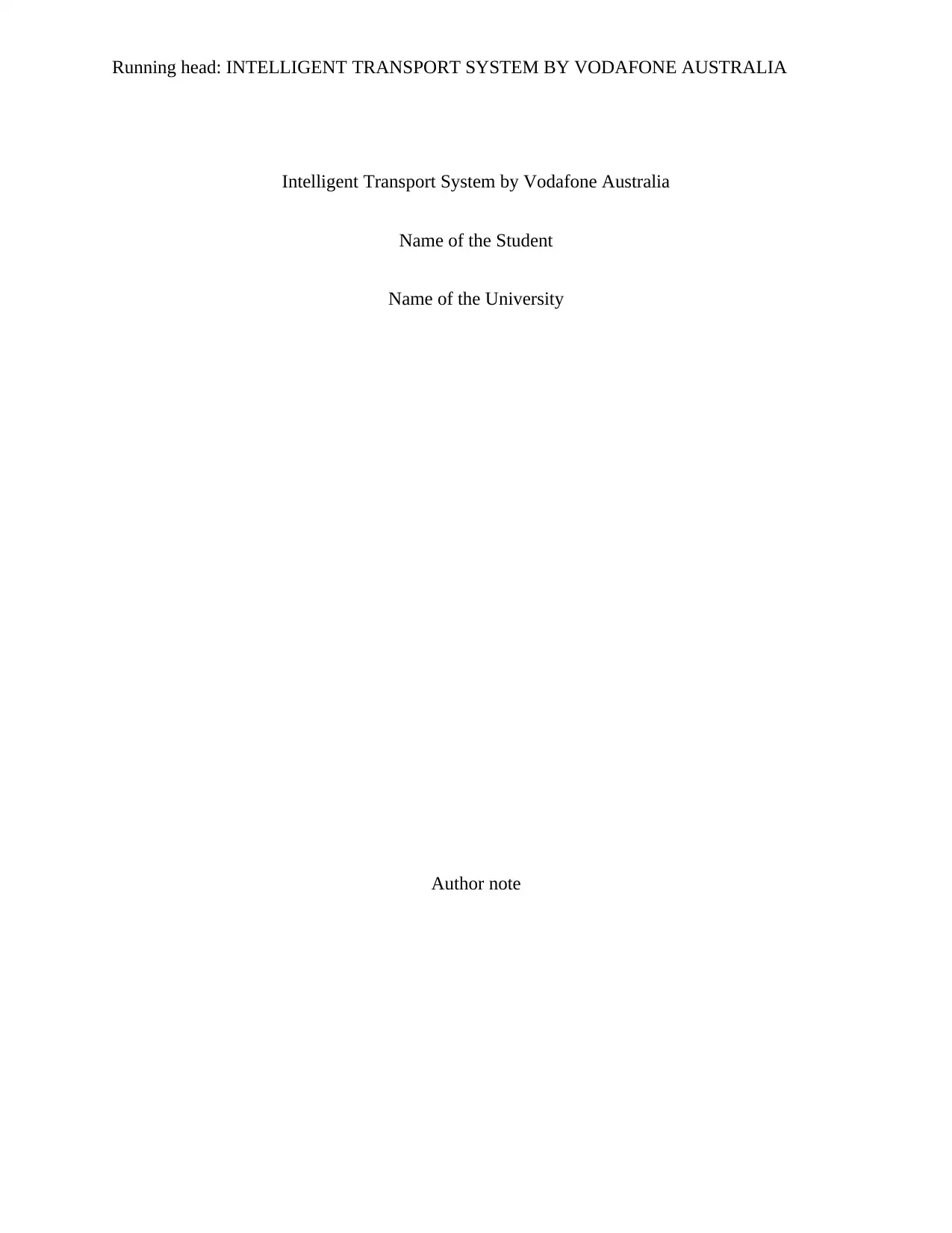
Running head: INTELLIGENT TRANSPORT SYSTEM BY VODAFONE AUSTRALIA
Intelligent Transport System by Vodafone Australia
Name of the Student
Name of the University
Author note
Intelligent Transport System by Vodafone Australia
Name of the Student
Name of the University
Author note
Secure Best Marks with AI Grader
Need help grading? Try our AI Grader for instant feedback on your assignments.
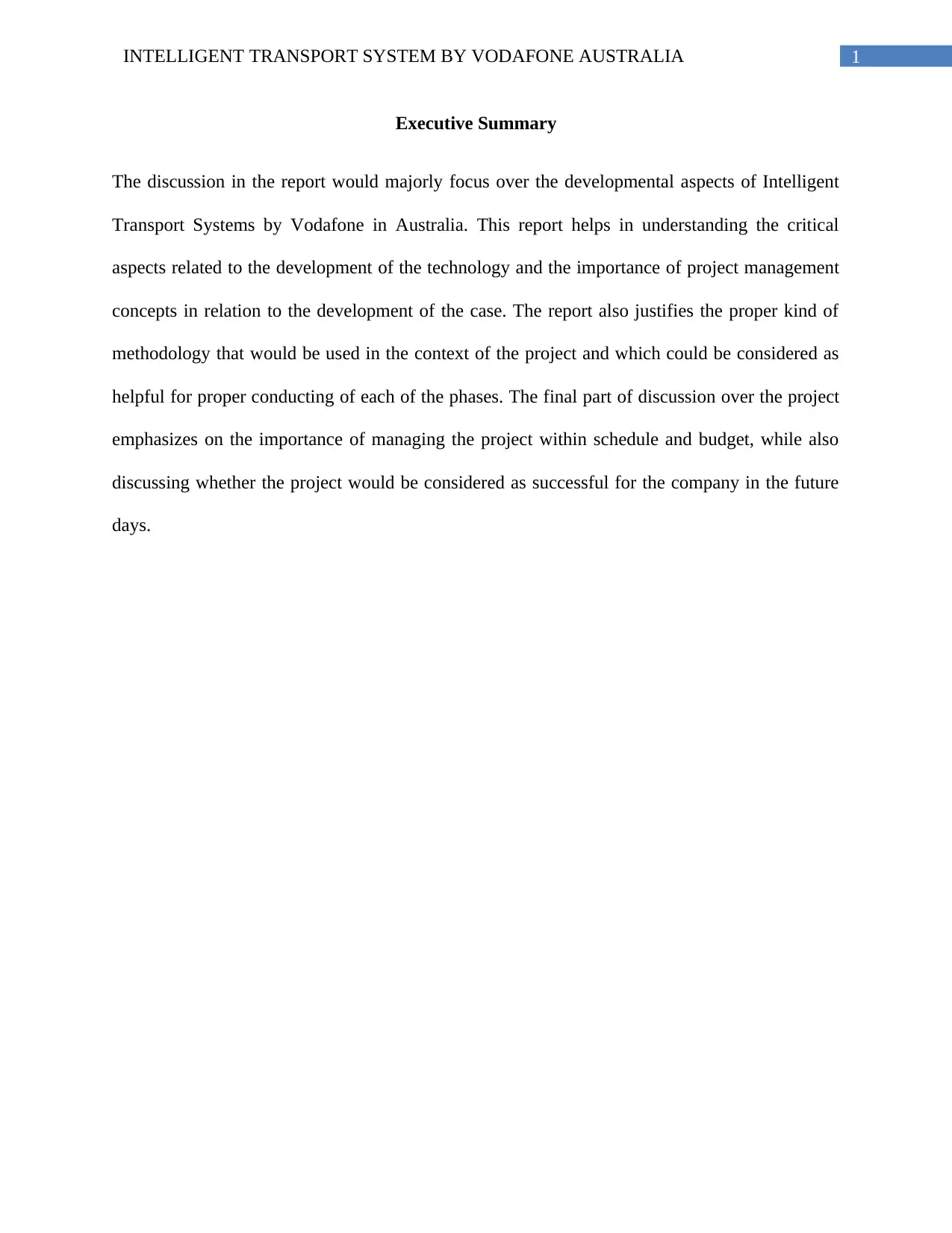
1INTELLIGENT TRANSPORT SYSTEM BY VODAFONE AUSTRALIA
Executive Summary
The discussion in the report would majorly focus over the developmental aspects of Intelligent
Transport Systems by Vodafone in Australia. This report helps in understanding the critical
aspects related to the development of the technology and the importance of project management
concepts in relation to the development of the case. The report also justifies the proper kind of
methodology that would be used in the context of the project and which could be considered as
helpful for proper conducting of each of the phases. The final part of discussion over the project
emphasizes on the importance of managing the project within schedule and budget, while also
discussing whether the project would be considered as successful for the company in the future
days.
Executive Summary
The discussion in the report would majorly focus over the developmental aspects of Intelligent
Transport Systems by Vodafone in Australia. This report helps in understanding the critical
aspects related to the development of the technology and the importance of project management
concepts in relation to the development of the case. The report also justifies the proper kind of
methodology that would be used in the context of the project and which could be considered as
helpful for proper conducting of each of the phases. The final part of discussion over the project
emphasizes on the importance of managing the project within schedule and budget, while also
discussing whether the project would be considered as successful for the company in the future
days.
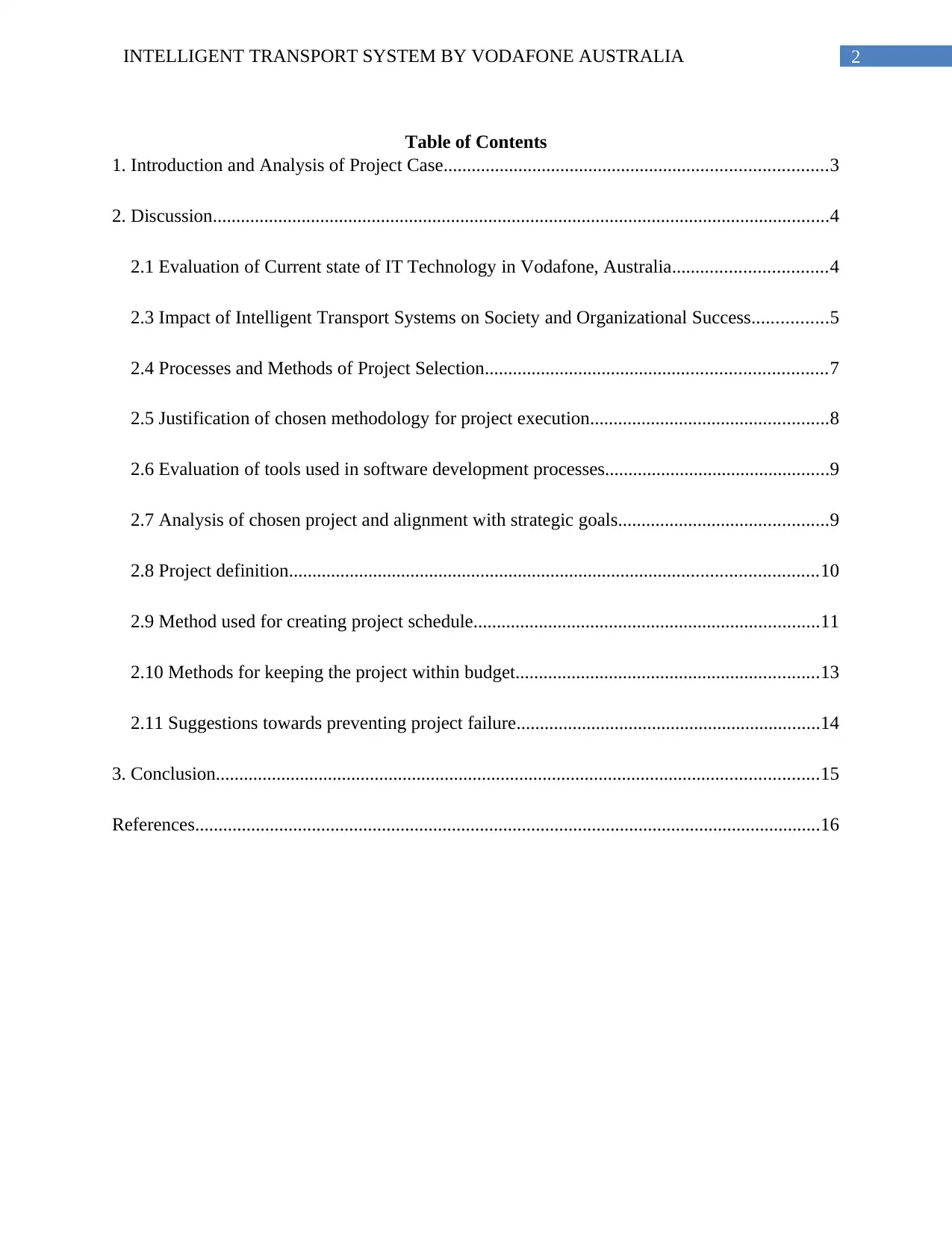
2INTELLIGENT TRANSPORT SYSTEM BY VODAFONE AUSTRALIA
Table of Contents
1. Introduction and Analysis of Project Case..................................................................................3
2. Discussion....................................................................................................................................4
2.1 Evaluation of Current state of IT Technology in Vodafone, Australia.................................4
2.3 Impact of Intelligent Transport Systems on Society and Organizational Success................5
2.4 Processes and Methods of Project Selection.........................................................................7
2.5 Justification of chosen methodology for project execution...................................................8
2.6 Evaluation of tools used in software development processes................................................9
2.7 Analysis of chosen project and alignment with strategic goals.............................................9
2.8 Project definition.................................................................................................................10
2.9 Method used for creating project schedule..........................................................................11
2.10 Methods for keeping the project within budget.................................................................13
2.11 Suggestions towards preventing project failure.................................................................14
3. Conclusion.................................................................................................................................15
References......................................................................................................................................16
Table of Contents
1. Introduction and Analysis of Project Case..................................................................................3
2. Discussion....................................................................................................................................4
2.1 Evaluation of Current state of IT Technology in Vodafone, Australia.................................4
2.3 Impact of Intelligent Transport Systems on Society and Organizational Success................5
2.4 Processes and Methods of Project Selection.........................................................................7
2.5 Justification of chosen methodology for project execution...................................................8
2.6 Evaluation of tools used in software development processes................................................9
2.7 Analysis of chosen project and alignment with strategic goals.............................................9
2.8 Project definition.................................................................................................................10
2.9 Method used for creating project schedule..........................................................................11
2.10 Methods for keeping the project within budget.................................................................13
2.11 Suggestions towards preventing project failure.................................................................14
3. Conclusion.................................................................................................................................15
References......................................................................................................................................16

3INTELLIGENT TRANSPORT SYSTEM BY VODAFONE AUSTRALIA
1. Introduction and Analysis of Project Case
Intelligent Transport Systems (ITS) can be considered as one of the most innovative kind
of technological innovation of the decade. With the primary concept of smart city transforming
towards digital societies, ITS would be becoming as an indispensable component among all the
citizens. With the purpose of leveraging citizens with the use of ITS, it would help in saving their
valuable time (Intelligent Transport System, 2020). It further helps in enriching users with local
convenience, providing prior information in relation to real-time traffic, supporting information
about seat availability and others. This would further help towards reduction of travel time for
various commuters while enhancing the comfort and safety.
According to recent reports by Vodafone Australia, the prediction of the autonomous
cars, which would be helping people in their daily routines, it has been predicted that the market
would be hit with $42 billion USD. The rise in the technology would also be able to create nearly
100,000 jobs by the year 2025.
In the recent times, with the growth of vehicles on the roads, traffic congestion is on a
major rise. Drivers mainly fail to establish a communication in real-time scenarios thus leading
to improper updates of road traffic, determining the time to reach somewhere and many other
aspects (Carutasu, Coculescu & Botezatu, 2017). With the implementation of smart transport
systems on roads, it would be majorly helpful to bring in value towards the transportation system
while leading efficient ways of travelling.
With the launch of the major initiative by Vodafone, the primary objectives set by the
business are:
1. Introduction and Analysis of Project Case
Intelligent Transport Systems (ITS) can be considered as one of the most innovative kind
of technological innovation of the decade. With the primary concept of smart city transforming
towards digital societies, ITS would be becoming as an indispensable component among all the
citizens. With the purpose of leveraging citizens with the use of ITS, it would help in saving their
valuable time (Intelligent Transport System, 2020). It further helps in enriching users with local
convenience, providing prior information in relation to real-time traffic, supporting information
about seat availability and others. This would further help towards reduction of travel time for
various commuters while enhancing the comfort and safety.
According to recent reports by Vodafone Australia, the prediction of the autonomous
cars, which would be helping people in their daily routines, it has been predicted that the market
would be hit with $42 billion USD. The rise in the technology would also be able to create nearly
100,000 jobs by the year 2025.
In the recent times, with the growth of vehicles on the roads, traffic congestion is on a
major rise. Drivers mainly fail to establish a communication in real-time scenarios thus leading
to improper updates of road traffic, determining the time to reach somewhere and many other
aspects (Carutasu, Coculescu & Botezatu, 2017). With the implementation of smart transport
systems on roads, it would be majorly helpful to bring in value towards the transportation system
while leading efficient ways of travelling.
With the launch of the major initiative by Vodafone, the primary objectives set by the
business are:
Paraphrase This Document
Need a fresh take? Get an instant paraphrase of this document with our AI Paraphraser
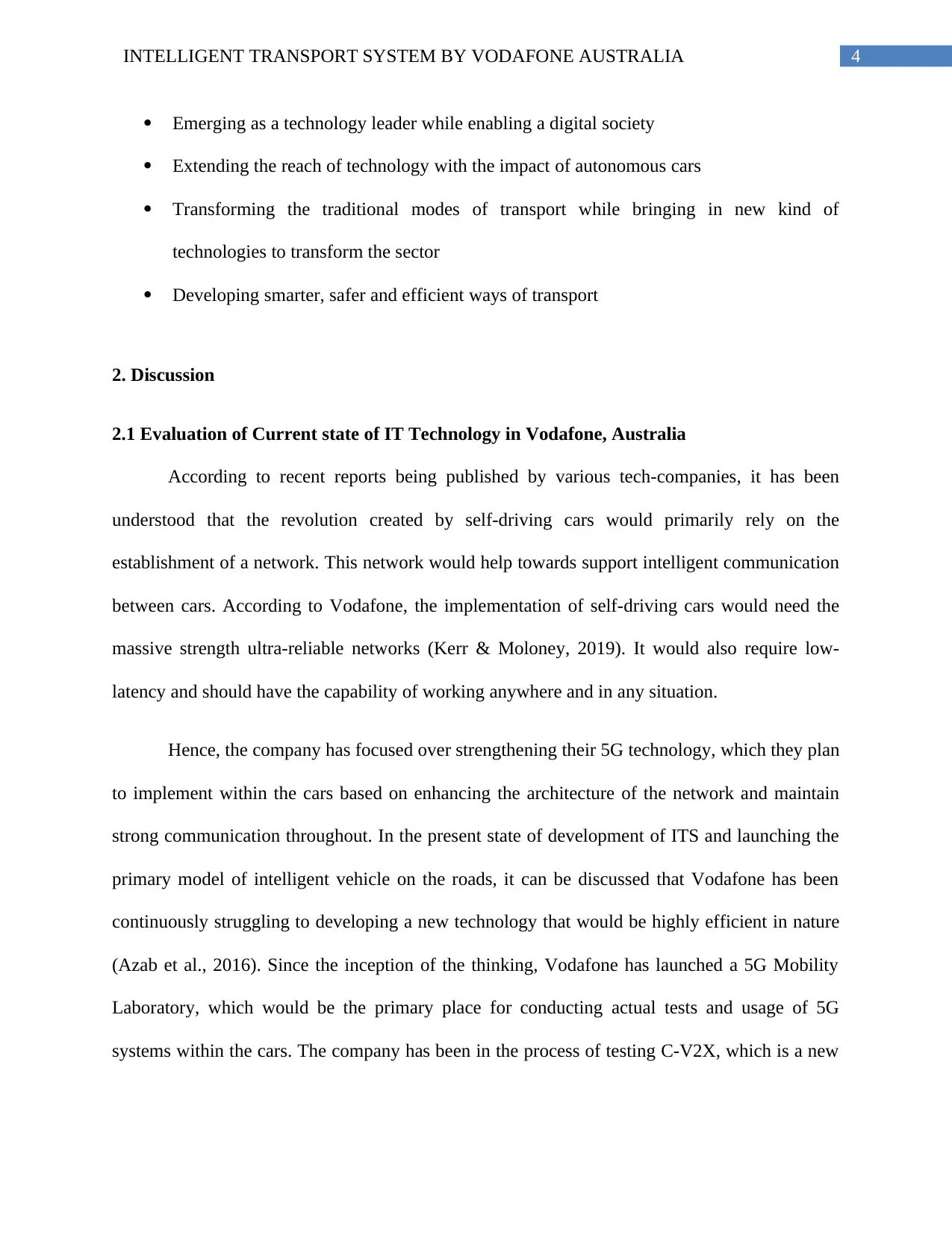
4INTELLIGENT TRANSPORT SYSTEM BY VODAFONE AUSTRALIA
Emerging as a technology leader while enabling a digital society
Extending the reach of technology with the impact of autonomous cars
Transforming the traditional modes of transport while bringing in new kind of
technologies to transform the sector
Developing smarter, safer and efficient ways of transport
2. Discussion
2.1 Evaluation of Current state of IT Technology in Vodafone, Australia
According to recent reports being published by various tech-companies, it has been
understood that the revolution created by self-driving cars would primarily rely on the
establishment of a network. This network would help towards support intelligent communication
between cars. According to Vodafone, the implementation of self-driving cars would need the
massive strength ultra-reliable networks (Kerr & Moloney, 2019). It would also require low-
latency and should have the capability of working anywhere and in any situation.
Hence, the company has focused over strengthening their 5G technology, which they plan
to implement within the cars based on enhancing the architecture of the network and maintain
strong communication throughout. In the present state of development of ITS and launching the
primary model of intelligent vehicle on the roads, it can be discussed that Vodafone has been
continuously struggling to developing a new technology that would be highly efficient in nature
(Azab et al., 2016). Since the inception of the thinking, Vodafone has launched a 5G Mobility
Laboratory, which would be the primary place for conducting actual tests and usage of 5G
systems within the cars. The company has been in the process of testing C-V2X, which is a new
Emerging as a technology leader while enabling a digital society
Extending the reach of technology with the impact of autonomous cars
Transforming the traditional modes of transport while bringing in new kind of
technologies to transform the sector
Developing smarter, safer and efficient ways of transport
2. Discussion
2.1 Evaluation of Current state of IT Technology in Vodafone, Australia
According to recent reports being published by various tech-companies, it has been
understood that the revolution created by self-driving cars would primarily rely on the
establishment of a network. This network would help towards support intelligent communication
between cars. According to Vodafone, the implementation of self-driving cars would need the
massive strength ultra-reliable networks (Kerr & Moloney, 2019). It would also require low-
latency and should have the capability of working anywhere and in any situation.
Hence, the company has focused over strengthening their 5G technology, which they plan
to implement within the cars based on enhancing the architecture of the network and maintain
strong communication throughout. In the present state of development of ITS and launching the
primary model of intelligent vehicle on the roads, it can be discussed that Vodafone has been
continuously struggling to developing a new technology that would be highly efficient in nature
(Azab et al., 2016). Since the inception of the thinking, Vodafone has launched a 5G Mobility
Laboratory, which would be the primary place for conducting actual tests and usage of 5G
systems within the cars. The company has been in the process of testing C-V2X, which is a new
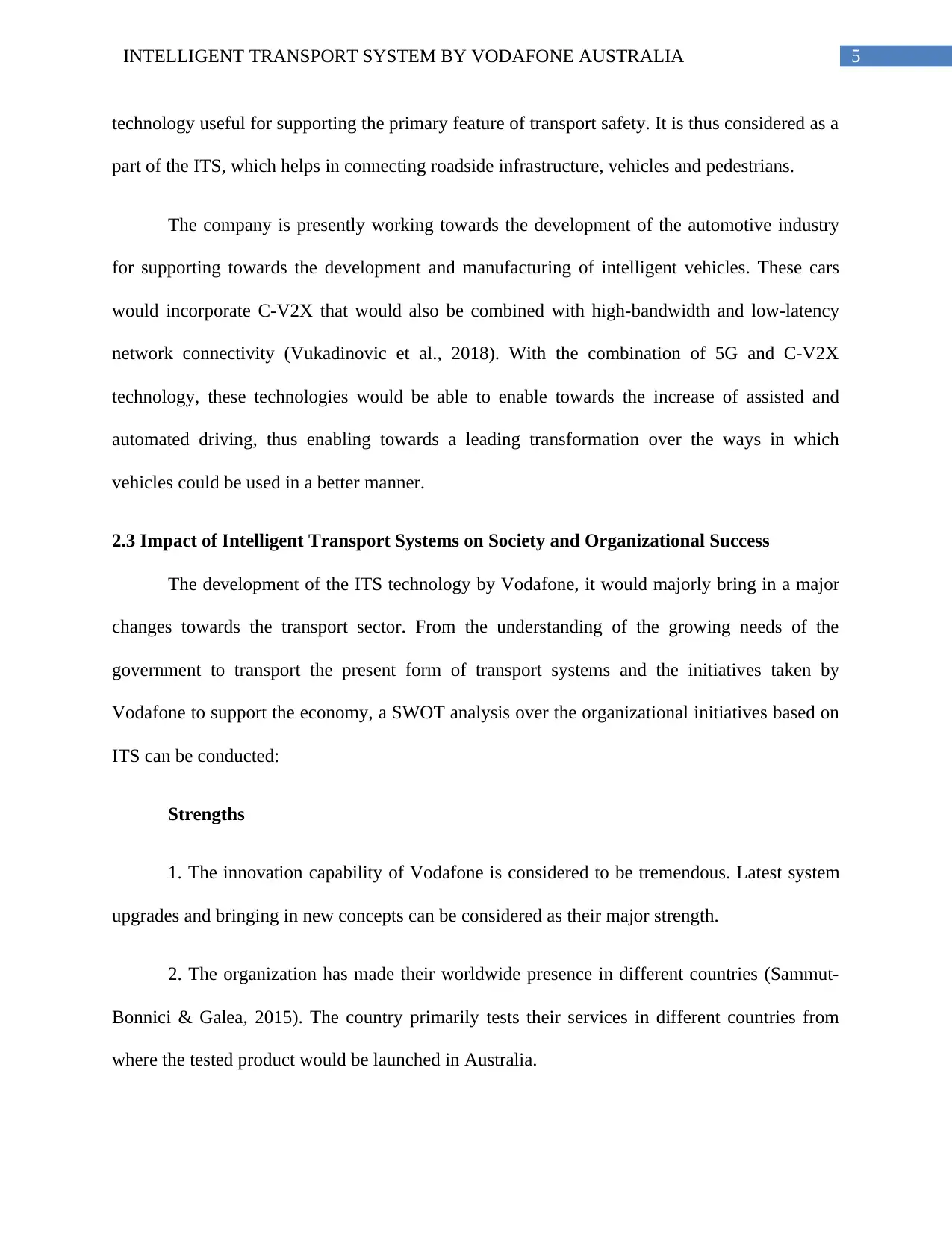
5INTELLIGENT TRANSPORT SYSTEM BY VODAFONE AUSTRALIA
technology useful for supporting the primary feature of transport safety. It is thus considered as a
part of the ITS, which helps in connecting roadside infrastructure, vehicles and pedestrians.
The company is presently working towards the development of the automotive industry
for supporting towards the development and manufacturing of intelligent vehicles. These cars
would incorporate C-V2X that would also be combined with high-bandwidth and low-latency
network connectivity (Vukadinovic et al., 2018). With the combination of 5G and C-V2X
technology, these technologies would be able to enable towards the increase of assisted and
automated driving, thus enabling towards a leading transformation over the ways in which
vehicles could be used in a better manner.
2.3 Impact of Intelligent Transport Systems on Society and Organizational Success
The development of the ITS technology by Vodafone, it would majorly bring in a major
changes towards the transport sector. From the understanding of the growing needs of the
government to transport the present form of transport systems and the initiatives taken by
Vodafone to support the economy, a SWOT analysis over the organizational initiatives based on
ITS can be conducted:
Strengths
1. The innovation capability of Vodafone is considered to be tremendous. Latest system
upgrades and bringing in new concepts can be considered as their major strength.
2. The organization has made their worldwide presence in different countries (Sammut‐
Bonnici & Galea, 2015). The country primarily tests their services in different countries from
where the tested product would be launched in Australia.
technology useful for supporting the primary feature of transport safety. It is thus considered as a
part of the ITS, which helps in connecting roadside infrastructure, vehicles and pedestrians.
The company is presently working towards the development of the automotive industry
for supporting towards the development and manufacturing of intelligent vehicles. These cars
would incorporate C-V2X that would also be combined with high-bandwidth and low-latency
network connectivity (Vukadinovic et al., 2018). With the combination of 5G and C-V2X
technology, these technologies would be able to enable towards the increase of assisted and
automated driving, thus enabling towards a leading transformation over the ways in which
vehicles could be used in a better manner.
2.3 Impact of Intelligent Transport Systems on Society and Organizational Success
The development of the ITS technology by Vodafone, it would majorly bring in a major
changes towards the transport sector. From the understanding of the growing needs of the
government to transport the present form of transport systems and the initiatives taken by
Vodafone to support the economy, a SWOT analysis over the organizational initiatives based on
ITS can be conducted:
Strengths
1. The innovation capability of Vodafone is considered to be tremendous. Latest system
upgrades and bringing in new concepts can be considered as their major strength.
2. The organization has made their worldwide presence in different countries (Sammut‐
Bonnici & Galea, 2015). The country primarily tests their services in different countries from
where the tested product would be launched in Australia.

6INTELLIGENT TRANSPORT SYSTEM BY VODAFONE AUSTRALIA
3. Vodafone has a large subscriber base and thus their designed products would be
greatly used by customers on a worldwide basis.
4. The company would also be able to strongly advertise for their services, which would
be launched. This can be considered as a great strategy for reaching out to a broad number of
customers.
Weakness
1. In realisation to the current technology being developed, it can be discussed that
Vodafone does not have a strong presence in rural areas. Hence, they would not be able to
propagate the technology to such sectors of people.
2. In present times, Vodafone has lost their market valuation. High competition, market
saturation and sluggish form of economic growth have led to the factor (Ang, 2016). Hence, the
innovative ITS technology would have to struggle to create a positive impact over the customer
mind.
Opportunities
1. Since, Vodafone does not have a strong reach in rural areas, hence the development of
ITS technological systems would prove to create the best impact over the minds of the people.
2. With the rise of mobile users and internet technology, people interested in purchasing
vehicles would be interested in purchasing new vehicles developed by Vodafone (Orlando,
2016).
3. Vodafone has a large subscriber base and thus their designed products would be
greatly used by customers on a worldwide basis.
4. The company would also be able to strongly advertise for their services, which would
be launched. This can be considered as a great strategy for reaching out to a broad number of
customers.
Weakness
1. In realisation to the current technology being developed, it can be discussed that
Vodafone does not have a strong presence in rural areas. Hence, they would not be able to
propagate the technology to such sectors of people.
2. In present times, Vodafone has lost their market valuation. High competition, market
saturation and sluggish form of economic growth have led to the factor (Ang, 2016). Hence, the
innovative ITS technology would have to struggle to create a positive impact over the customer
mind.
Opportunities
1. Since, Vodafone does not have a strong reach in rural areas, hence the development of
ITS technological systems would prove to create the best impact over the minds of the people.
2. With the rise of mobile users and internet technology, people interested in purchasing
vehicles would be interested in purchasing new vehicles developed by Vodafone (Orlando,
2016).
Secure Best Marks with AI Grader
Need help grading? Try our AI Grader for instant feedback on your assignments.
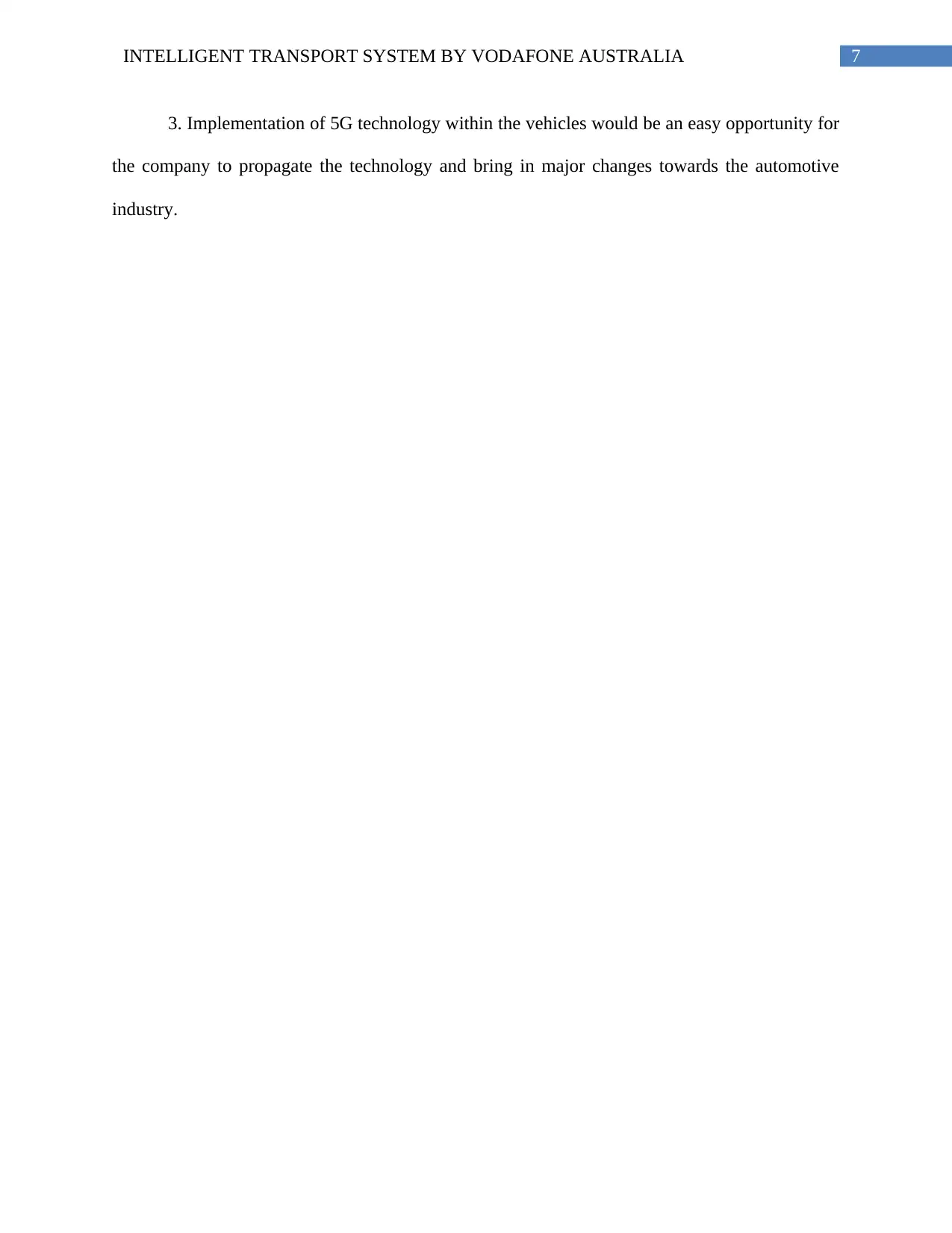
7INTELLIGENT TRANSPORT SYSTEM BY VODAFONE AUSTRALIA
3. Implementation of 5G technology within the vehicles would be an easy opportunity for
the company to propagate the technology and bring in major changes towards the automotive
industry.
3. Implementation of 5G technology within the vehicles would be an easy opportunity for
the company to propagate the technology and bring in major changes towards the automotive
industry.
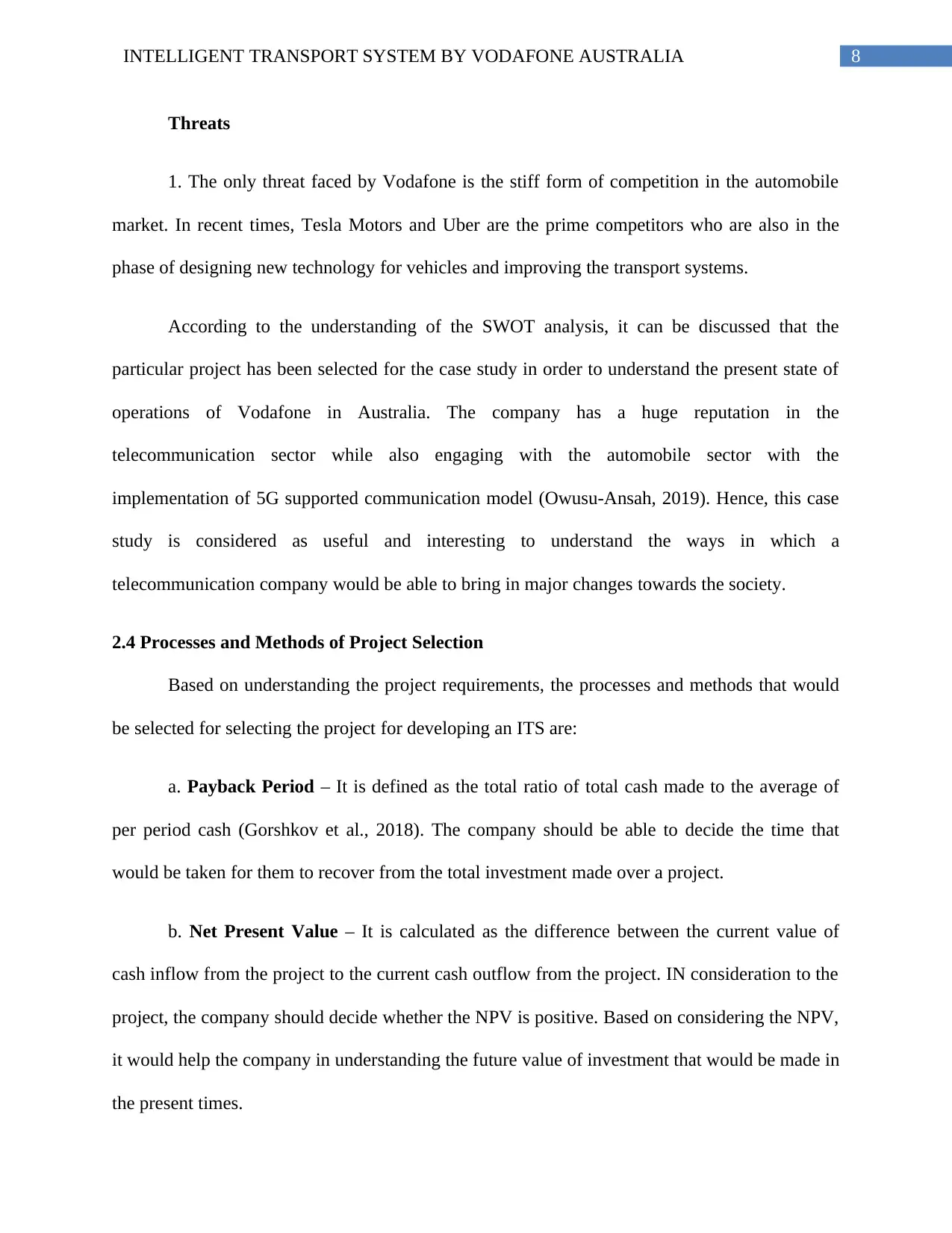
8INTELLIGENT TRANSPORT SYSTEM BY VODAFONE AUSTRALIA
Threats
1. The only threat faced by Vodafone is the stiff form of competition in the automobile
market. In recent times, Tesla Motors and Uber are the prime competitors who are also in the
phase of designing new technology for vehicles and improving the transport systems.
According to the understanding of the SWOT analysis, it can be discussed that the
particular project has been selected for the case study in order to understand the present state of
operations of Vodafone in Australia. The company has a huge reputation in the
telecommunication sector while also engaging with the automobile sector with the
implementation of 5G supported communication model (Owusu-Ansah, 2019). Hence, this case
study is considered as useful and interesting to understand the ways in which a
telecommunication company would be able to bring in major changes towards the society.
2.4 Processes and Methods of Project Selection
Based on understanding the project requirements, the processes and methods that would
be selected for selecting the project for developing an ITS are:
a. Payback Period – It is defined as the total ratio of total cash made to the average of
per period cash (Gorshkov et al., 2018). The company should be able to decide the time that
would be taken for them to recover from the total investment made over a project.
b. Net Present Value – It is calculated as the difference between the current value of
cash inflow from the project to the current cash outflow from the project. IN consideration to the
project, the company should decide whether the NPV is positive. Based on considering the NPV,
it would help the company in understanding the future value of investment that would be made in
the present times.
Threats
1. The only threat faced by Vodafone is the stiff form of competition in the automobile
market. In recent times, Tesla Motors and Uber are the prime competitors who are also in the
phase of designing new technology for vehicles and improving the transport systems.
According to the understanding of the SWOT analysis, it can be discussed that the
particular project has been selected for the case study in order to understand the present state of
operations of Vodafone in Australia. The company has a huge reputation in the
telecommunication sector while also engaging with the automobile sector with the
implementation of 5G supported communication model (Owusu-Ansah, 2019). Hence, this case
study is considered as useful and interesting to understand the ways in which a
telecommunication company would be able to bring in major changes towards the society.
2.4 Processes and Methods of Project Selection
Based on understanding the project requirements, the processes and methods that would
be selected for selecting the project for developing an ITS are:
a. Payback Period – It is defined as the total ratio of total cash made to the average of
per period cash (Gorshkov et al., 2018). The company should be able to decide the time that
would be taken for them to recover from the total investment made over a project.
b. Net Present Value – It is calculated as the difference between the current value of
cash inflow from the project to the current cash outflow from the project. IN consideration to the
project, the company should decide whether the NPV is positive. Based on considering the NPV,
it would help the company in understanding the future value of investment that would be made in
the present times.
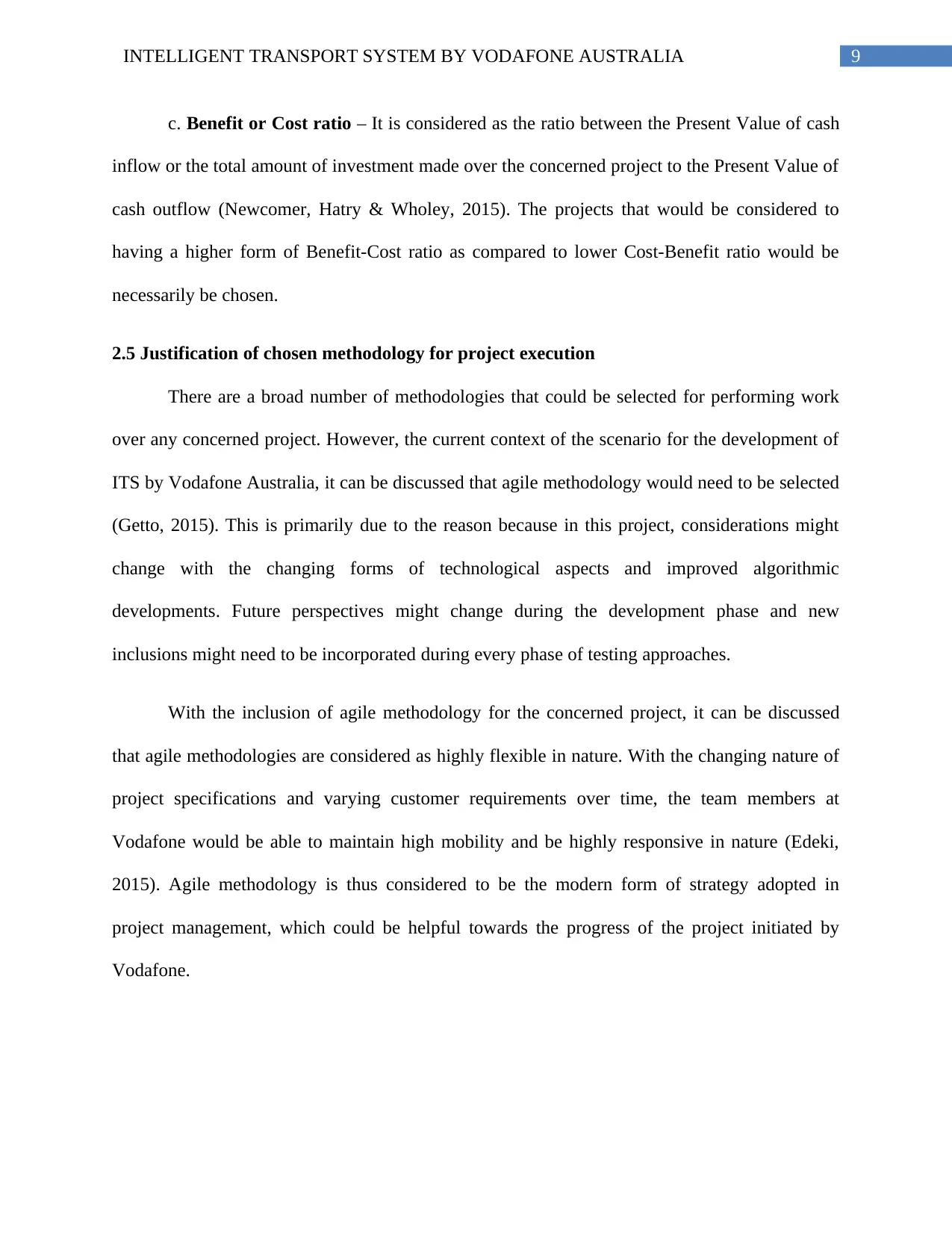
9INTELLIGENT TRANSPORT SYSTEM BY VODAFONE AUSTRALIA
c. Benefit or Cost ratio – It is considered as the ratio between the Present Value of cash
inflow or the total amount of investment made over the concerned project to the Present Value of
cash outflow (Newcomer, Hatry & Wholey, 2015). The projects that would be considered to
having a higher form of Benefit-Cost ratio as compared to lower Cost-Benefit ratio would be
necessarily be chosen.
2.5 Justification of chosen methodology for project execution
There are a broad number of methodologies that could be selected for performing work
over any concerned project. However, the current context of the scenario for the development of
ITS by Vodafone Australia, it can be discussed that agile methodology would need to be selected
(Getto, 2015). This is primarily due to the reason because in this project, considerations might
change with the changing forms of technological aspects and improved algorithmic
developments. Future perspectives might change during the development phase and new
inclusions might need to be incorporated during every phase of testing approaches.
With the inclusion of agile methodology for the concerned project, it can be discussed
that agile methodologies are considered as highly flexible in nature. With the changing nature of
project specifications and varying customer requirements over time, the team members at
Vodafone would be able to maintain high mobility and be highly responsive in nature (Edeki,
2015). Agile methodology is thus considered to be the modern form of strategy adopted in
project management, which could be helpful towards the progress of the project initiated by
Vodafone.
c. Benefit or Cost ratio – It is considered as the ratio between the Present Value of cash
inflow or the total amount of investment made over the concerned project to the Present Value of
cash outflow (Newcomer, Hatry & Wholey, 2015). The projects that would be considered to
having a higher form of Benefit-Cost ratio as compared to lower Cost-Benefit ratio would be
necessarily be chosen.
2.5 Justification of chosen methodology for project execution
There are a broad number of methodologies that could be selected for performing work
over any concerned project. However, the current context of the scenario for the development of
ITS by Vodafone Australia, it can be discussed that agile methodology would need to be selected
(Getto, 2015). This is primarily due to the reason because in this project, considerations might
change with the changing forms of technological aspects and improved algorithmic
developments. Future perspectives might change during the development phase and new
inclusions might need to be incorporated during every phase of testing approaches.
With the inclusion of agile methodology for the concerned project, it can be discussed
that agile methodologies are considered as highly flexible in nature. With the changing nature of
project specifications and varying customer requirements over time, the team members at
Vodafone would be able to maintain high mobility and be highly responsive in nature (Edeki,
2015). Agile methodology is thus considered to be the modern form of strategy adopted in
project management, which could be helpful towards the progress of the project initiated by
Vodafone.
Paraphrase This Document
Need a fresh take? Get an instant paraphrase of this document with our AI Paraphraser
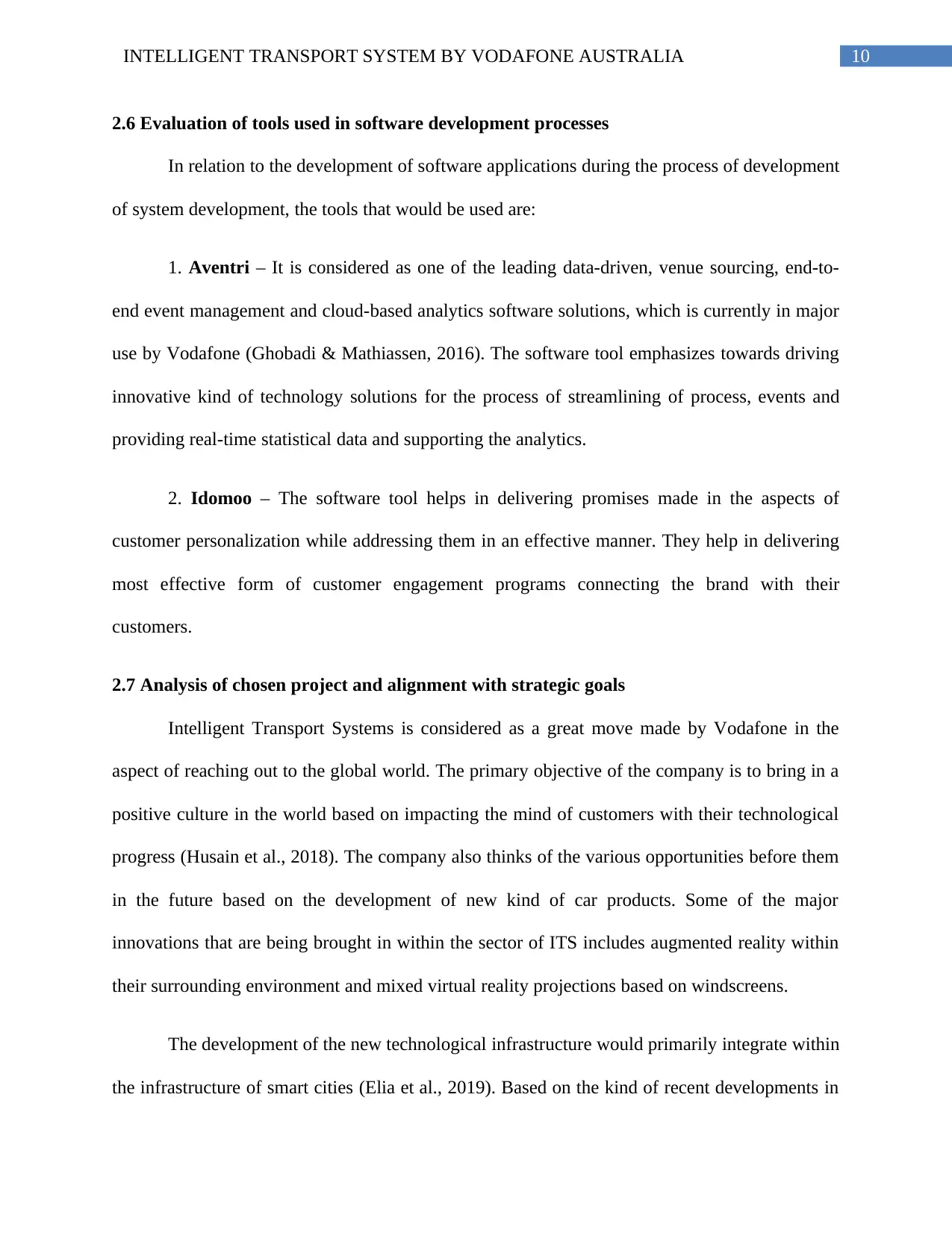
10INTELLIGENT TRANSPORT SYSTEM BY VODAFONE AUSTRALIA
2.6 Evaluation of tools used in software development processes
In relation to the development of software applications during the process of development
of system development, the tools that would be used are:
1. Aventri – It is considered as one of the leading data-driven, venue sourcing, end-to-
end event management and cloud-based analytics software solutions, which is currently in major
use by Vodafone (Ghobadi & Mathiassen, 2016). The software tool emphasizes towards driving
innovative kind of technology solutions for the process of streamlining of process, events and
providing real-time statistical data and supporting the analytics.
2. Idomoo – The software tool helps in delivering promises made in the aspects of
customer personalization while addressing them in an effective manner. They help in delivering
most effective form of customer engagement programs connecting the brand with their
customers.
2.7 Analysis of chosen project and alignment with strategic goals
Intelligent Transport Systems is considered as a great move made by Vodafone in the
aspect of reaching out to the global world. The primary objective of the company is to bring in a
positive culture in the world based on impacting the mind of customers with their technological
progress (Husain et al., 2018). The company also thinks of the various opportunities before them
in the future based on the development of new kind of car products. Some of the major
innovations that are being brought in within the sector of ITS includes augmented reality within
their surrounding environment and mixed virtual reality projections based on windscreens.
The development of the new technological infrastructure would primarily integrate within
the infrastructure of smart cities (Elia et al., 2019). Based on the kind of recent developments in
2.6 Evaluation of tools used in software development processes
In relation to the development of software applications during the process of development
of system development, the tools that would be used are:
1. Aventri – It is considered as one of the leading data-driven, venue sourcing, end-to-
end event management and cloud-based analytics software solutions, which is currently in major
use by Vodafone (Ghobadi & Mathiassen, 2016). The software tool emphasizes towards driving
innovative kind of technology solutions for the process of streamlining of process, events and
providing real-time statistical data and supporting the analytics.
2. Idomoo – The software tool helps in delivering promises made in the aspects of
customer personalization while addressing them in an effective manner. They help in delivering
most effective form of customer engagement programs connecting the brand with their
customers.
2.7 Analysis of chosen project and alignment with strategic goals
Intelligent Transport Systems is considered as a great move made by Vodafone in the
aspect of reaching out to the global world. The primary objective of the company is to bring in a
positive culture in the world based on impacting the mind of customers with their technological
progress (Husain et al., 2018). The company also thinks of the various opportunities before them
in the future based on the development of new kind of car products. Some of the major
innovations that are being brought in within the sector of ITS includes augmented reality within
their surrounding environment and mixed virtual reality projections based on windscreens.
The development of the new technological infrastructure would primarily integrate within
the infrastructure of smart cities (Elia et al., 2019). Based on the kind of recent developments in
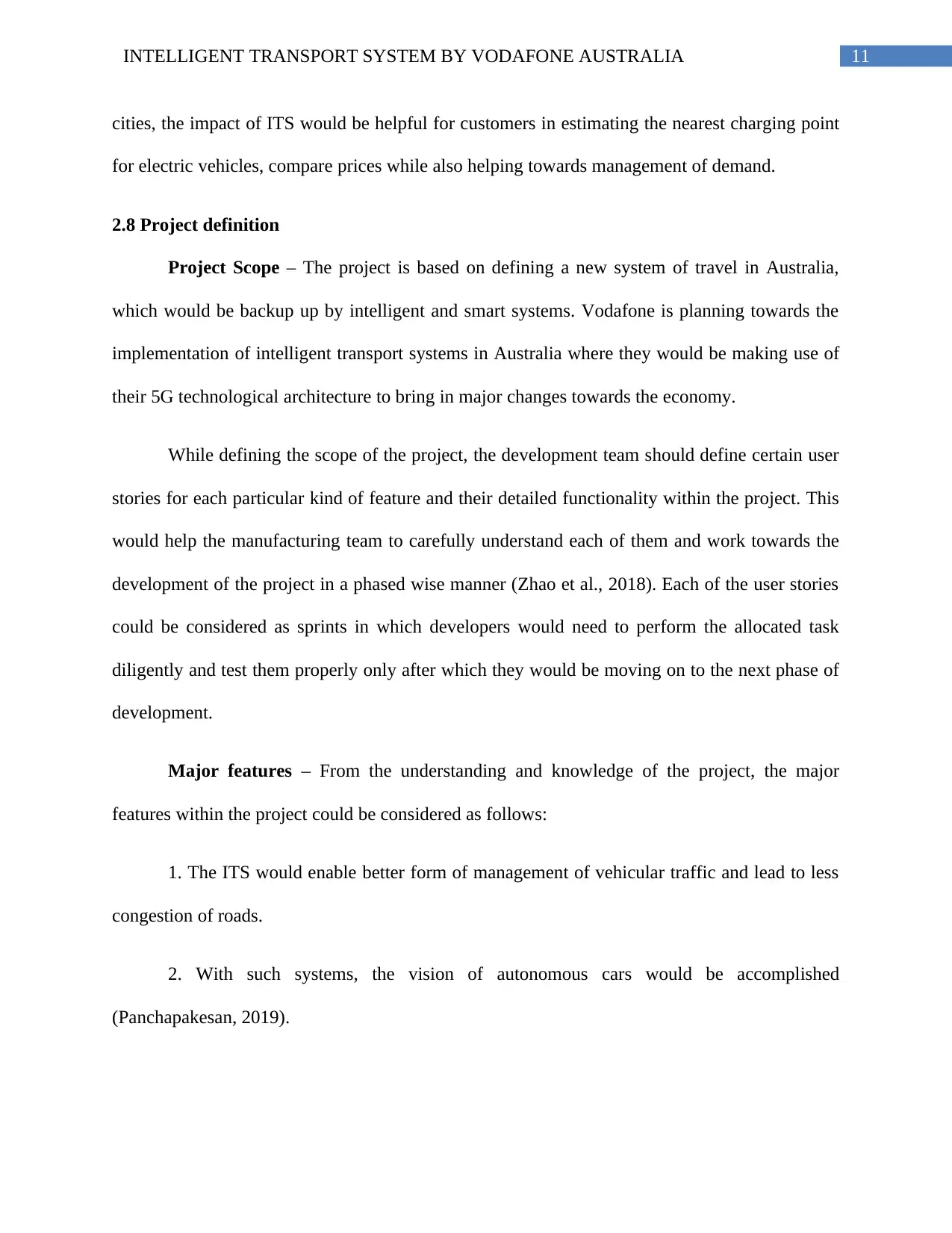
11INTELLIGENT TRANSPORT SYSTEM BY VODAFONE AUSTRALIA
cities, the impact of ITS would be helpful for customers in estimating the nearest charging point
for electric vehicles, compare prices while also helping towards management of demand.
2.8 Project definition
Project Scope – The project is based on defining a new system of travel in Australia,
which would be backup up by intelligent and smart systems. Vodafone is planning towards the
implementation of intelligent transport systems in Australia where they would be making use of
their 5G technological architecture to bring in major changes towards the economy.
While defining the scope of the project, the development team should define certain user
stories for each particular kind of feature and their detailed functionality within the project. This
would help the manufacturing team to carefully understand each of them and work towards the
development of the project in a phased wise manner (Zhao et al., 2018). Each of the user stories
could be considered as sprints in which developers would need to perform the allocated task
diligently and test them properly only after which they would be moving on to the next phase of
development.
Major features – From the understanding and knowledge of the project, the major
features within the project could be considered as follows:
1. The ITS would enable better form of management of vehicular traffic and lead to less
congestion of roads.
2. With such systems, the vision of autonomous cars would be accomplished
(Panchapakesan, 2019).
cities, the impact of ITS would be helpful for customers in estimating the nearest charging point
for electric vehicles, compare prices while also helping towards management of demand.
2.8 Project definition
Project Scope – The project is based on defining a new system of travel in Australia,
which would be backup up by intelligent and smart systems. Vodafone is planning towards the
implementation of intelligent transport systems in Australia where they would be making use of
their 5G technological architecture to bring in major changes towards the economy.
While defining the scope of the project, the development team should define certain user
stories for each particular kind of feature and their detailed functionality within the project. This
would help the manufacturing team to carefully understand each of them and work towards the
development of the project in a phased wise manner (Zhao et al., 2018). Each of the user stories
could be considered as sprints in which developers would need to perform the allocated task
diligently and test them properly only after which they would be moving on to the next phase of
development.
Major features – From the understanding and knowledge of the project, the major
features within the project could be considered as follows:
1. The ITS would enable better form of management of vehicular traffic and lead to less
congestion of roads.
2. With such systems, the vision of autonomous cars would be accomplished
(Panchapakesan, 2019).
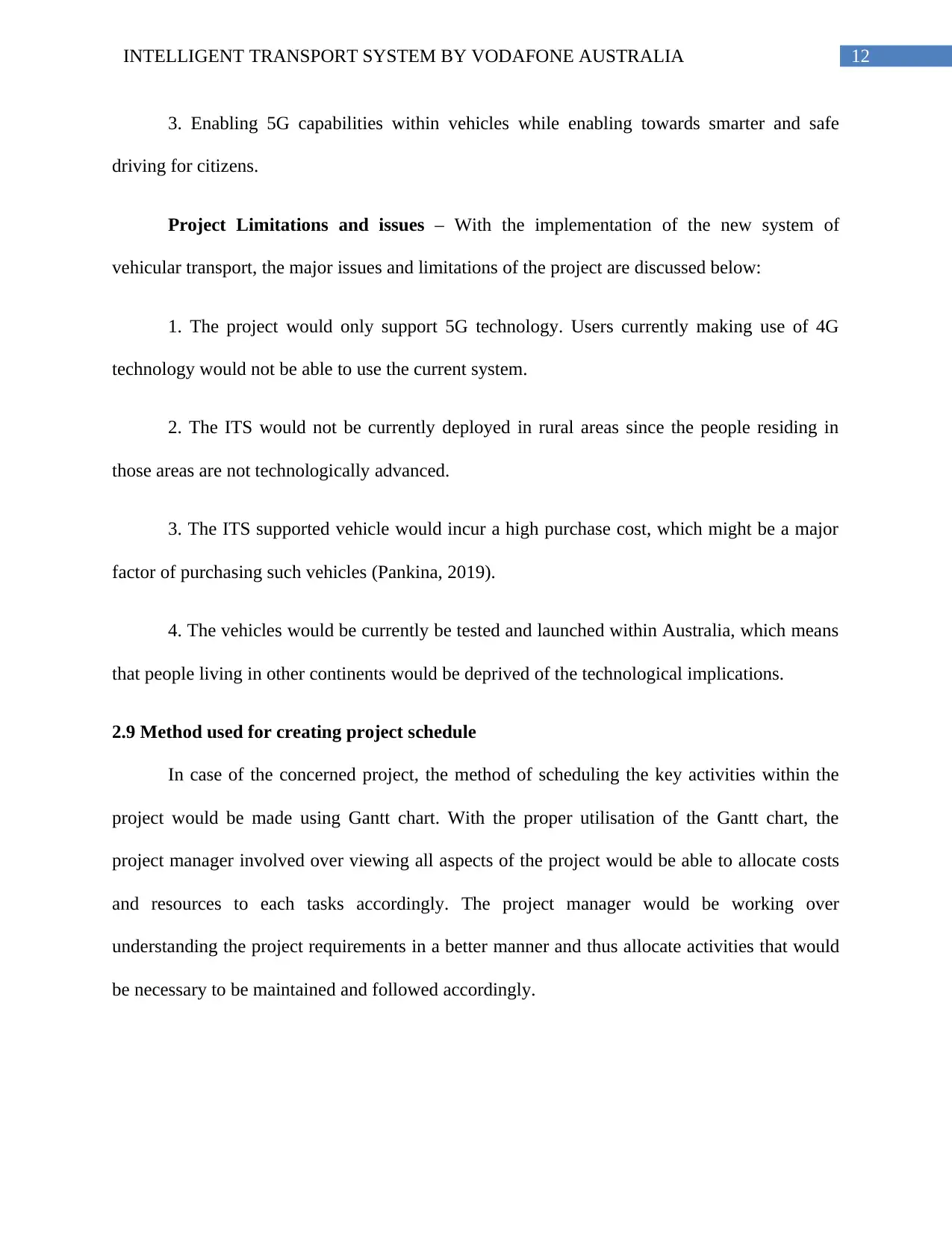
12INTELLIGENT TRANSPORT SYSTEM BY VODAFONE AUSTRALIA
3. Enabling 5G capabilities within vehicles while enabling towards smarter and safe
driving for citizens.
Project Limitations and issues – With the implementation of the new system of
vehicular transport, the major issues and limitations of the project are discussed below:
1. The project would only support 5G technology. Users currently making use of 4G
technology would not be able to use the current system.
2. The ITS would not be currently deployed in rural areas since the people residing in
those areas are not technologically advanced.
3. The ITS supported vehicle would incur a high purchase cost, which might be a major
factor of purchasing such vehicles (Pankina, 2019).
4. The vehicles would be currently be tested and launched within Australia, which means
that people living in other continents would be deprived of the technological implications.
2.9 Method used for creating project schedule
In case of the concerned project, the method of scheduling the key activities within the
project would be made using Gantt chart. With the proper utilisation of the Gantt chart, the
project manager involved over viewing all aspects of the project would be able to allocate costs
and resources to each tasks accordingly. The project manager would be working over
understanding the project requirements in a better manner and thus allocate activities that would
be necessary to be maintained and followed accordingly.
3. Enabling 5G capabilities within vehicles while enabling towards smarter and safe
driving for citizens.
Project Limitations and issues – With the implementation of the new system of
vehicular transport, the major issues and limitations of the project are discussed below:
1. The project would only support 5G technology. Users currently making use of 4G
technology would not be able to use the current system.
2. The ITS would not be currently deployed in rural areas since the people residing in
those areas are not technologically advanced.
3. The ITS supported vehicle would incur a high purchase cost, which might be a major
factor of purchasing such vehicles (Pankina, 2019).
4. The vehicles would be currently be tested and launched within Australia, which means
that people living in other continents would be deprived of the technological implications.
2.9 Method used for creating project schedule
In case of the concerned project, the method of scheduling the key activities within the
project would be made using Gantt chart. With the proper utilisation of the Gantt chart, the
project manager involved over viewing all aspects of the project would be able to allocate costs
and resources to each tasks accordingly. The project manager would be working over
understanding the project requirements in a better manner and thus allocate activities that would
be necessary to be maintained and followed accordingly.
Secure Best Marks with AI Grader
Need help grading? Try our AI Grader for instant feedback on your assignments.
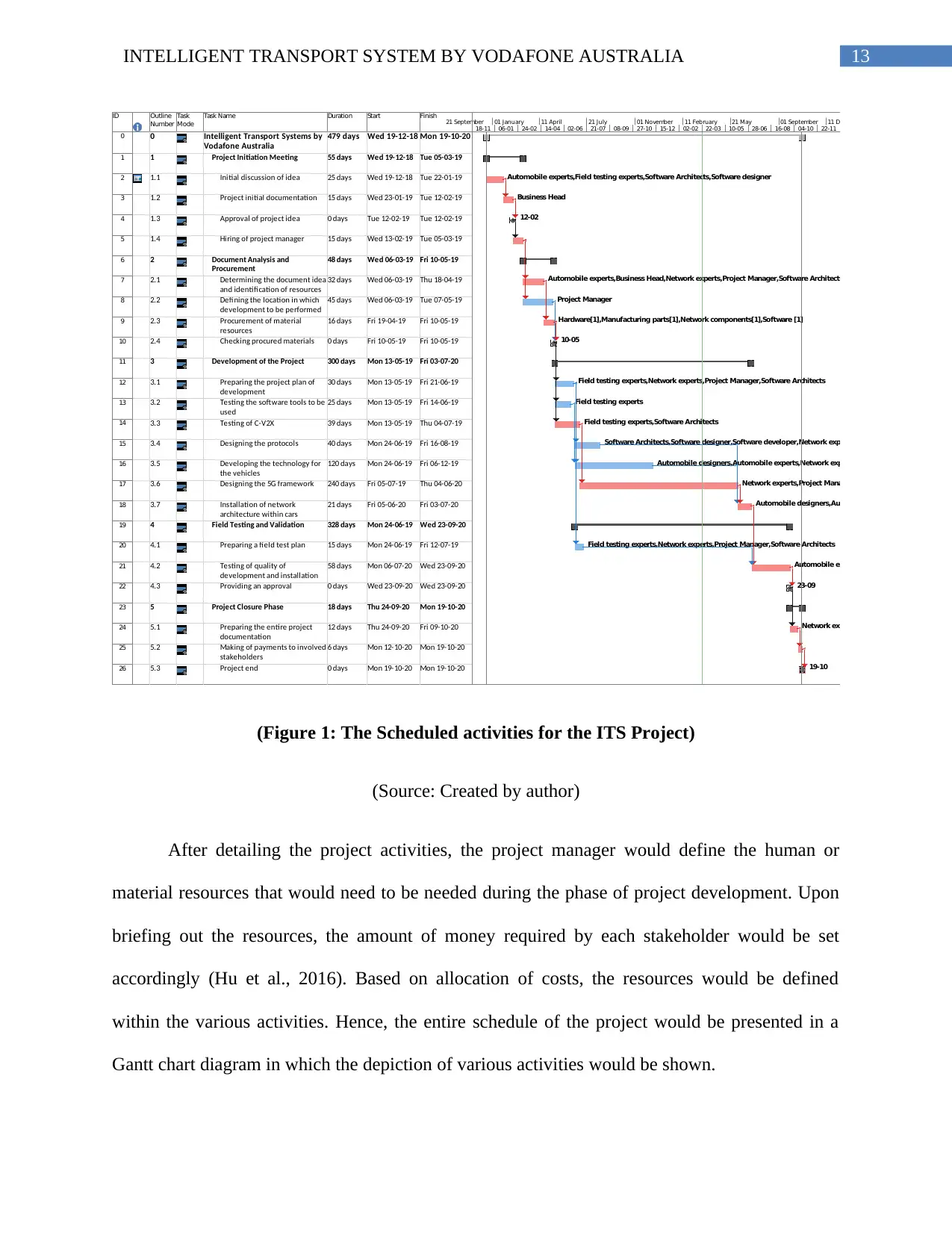
13INTELLIGENT TRANSPORT SYSTEM BY VODAFONE AUSTRALIA
ID Outline
Number
Task
Mode
Task Name Duration Start Finish
0 0 Intelligent Transport Systems by
Vodafone Australia
479 days Wed 19-12-18 Mon 19-10-20
1 1 Project Initiation Meeting 55 days Wed 19-12-18 Tue 05-03-19
2 1.1 Initial discussion of idea 25 days Wed 19-12-18 Tue 22-01-19
3 1.2 Project initial documentation 15 days Wed 23-01-19 Tue 12-02-19
4 1.3 Approval of project idea 0 days Tue 12-02-19 Tue 12-02-19
5 1.4 Hiring of project manager 15 days Wed 13-02-19 Tue 05-03-19
6 2 Document Analysis and
Procurement
48 days Wed 06-03-19 Fri 10-05-19
7 2.1 Determining the document idea
and identification of resources
32 days Wed 06-03-19 Thu 18-04-19
8 2.2 Defining the location in which
development to be performed
45 days Wed 06-03-19 Tue 07-05-19
9 2.3 Procurement of material
resources
16 days Fri 19-04-19 Fri 10-05-19
10 2.4 Checking procured materials 0 days Fri 10-05-19 Fri 10-05-19
11 3 Development of the Project 300 days Mon 13-05-19 Fri 03-07-20
12 3.1 Preparing the project plan of
development
30 days Mon 13-05-19 Fri 21-06-19
13 3.2 Testing the software tools to be
used
25 days Mon 13-05-19 Fri 14-06-19
14 3.3 Testing of C-V2X 39 days Mon 13-05-19 Thu 04-07-19
15 3.4 Designing the protocols 40 days Mon 24-06-19 Fri 16-08-19
16 3.5 Developing the technology for
the vehicles
120 days Mon 24-06-19 Fri 06-12-19
17 3.6 Designing the 5G framework 240 days Fri 05-07-19 Thu 04-06-20
18 3.7 Installation of network
architecture within cars
21 days Fri 05-06-20 Fri 03-07-20
19 4 Field Testing and Validation 328 days Mon 24-06-19 Wed 23-09-20
20 4.1 Preparing a field test plan 15 days Mon 24-06-19 Fri 12-07-19
21 4.2 Testing of quality of
development and installation
58 days Mon 06-07-20 Wed 23-09-20
22 4.3 Providing an approval 0 days Wed 23-09-20 Wed 23-09-20
23 5 Project Closure Phase 18 days Thu 24-09-20 Mon 19-10-20
24 5.1 Preparing the entire project
documentation
12 days Thu 24-09-20 Fri 09-10-20
25 5.2 Making of payments to involved
stakeholders
6 days Mon 12-10-20 Mon 19-10-20
26 5.3 Project end 0 days Mon 19-10-20 Mon 19-10-20
Automobile experts,Field testing experts,Software Architects,Software designer
Business Head
12-02
Automobile experts,Business Head,Network experts,Project Manager,Software Architects
Project Manager
Hardware[1],Manufacturing parts[1],Network components[1],Software [1]
10-05
Field testing experts,Network experts,Project Manager,Software Architects
Field testing experts
Field testing experts,Software Architects
Software Architects,Software designer,Software developer,Network experts
Automobile designers,Automobile experts,Network experts,Project Manager,Software Arc
Network experts,Project Manager
Automobile designers,Automobile experts,Field testing exp
Field testing experts,Network experts,Project Manager,Software Architects
Automobile experts,Network experts,Software A
23-09
Network experts,Project Manager,Software Ar
19-10
18-11 06-01 24-02 14-04 02-06 21-07 08-09 27-10 15-12 02-02 22-03 10-05 28-06 16-08 04-10 22-11 10-01
21 September 01 January 11 April 21 July 01 November 11 February 21 May 01 September 11 December
(Figure 1: The Scheduled activities for the ITS Project)
(Source: Created by author)
After detailing the project activities, the project manager would define the human or
material resources that would need to be needed during the phase of project development. Upon
briefing out the resources, the amount of money required by each stakeholder would be set
accordingly (Hu et al., 2016). Based on allocation of costs, the resources would be defined
within the various activities. Hence, the entire schedule of the project would be presented in a
Gantt chart diagram in which the depiction of various activities would be shown.
ID Outline
Number
Task
Mode
Task Name Duration Start Finish
0 0 Intelligent Transport Systems by
Vodafone Australia
479 days Wed 19-12-18 Mon 19-10-20
1 1 Project Initiation Meeting 55 days Wed 19-12-18 Tue 05-03-19
2 1.1 Initial discussion of idea 25 days Wed 19-12-18 Tue 22-01-19
3 1.2 Project initial documentation 15 days Wed 23-01-19 Tue 12-02-19
4 1.3 Approval of project idea 0 days Tue 12-02-19 Tue 12-02-19
5 1.4 Hiring of project manager 15 days Wed 13-02-19 Tue 05-03-19
6 2 Document Analysis and
Procurement
48 days Wed 06-03-19 Fri 10-05-19
7 2.1 Determining the document idea
and identification of resources
32 days Wed 06-03-19 Thu 18-04-19
8 2.2 Defining the location in which
development to be performed
45 days Wed 06-03-19 Tue 07-05-19
9 2.3 Procurement of material
resources
16 days Fri 19-04-19 Fri 10-05-19
10 2.4 Checking procured materials 0 days Fri 10-05-19 Fri 10-05-19
11 3 Development of the Project 300 days Mon 13-05-19 Fri 03-07-20
12 3.1 Preparing the project plan of
development
30 days Mon 13-05-19 Fri 21-06-19
13 3.2 Testing the software tools to be
used
25 days Mon 13-05-19 Fri 14-06-19
14 3.3 Testing of C-V2X 39 days Mon 13-05-19 Thu 04-07-19
15 3.4 Designing the protocols 40 days Mon 24-06-19 Fri 16-08-19
16 3.5 Developing the technology for
the vehicles
120 days Mon 24-06-19 Fri 06-12-19
17 3.6 Designing the 5G framework 240 days Fri 05-07-19 Thu 04-06-20
18 3.7 Installation of network
architecture within cars
21 days Fri 05-06-20 Fri 03-07-20
19 4 Field Testing and Validation 328 days Mon 24-06-19 Wed 23-09-20
20 4.1 Preparing a field test plan 15 days Mon 24-06-19 Fri 12-07-19
21 4.2 Testing of quality of
development and installation
58 days Mon 06-07-20 Wed 23-09-20
22 4.3 Providing an approval 0 days Wed 23-09-20 Wed 23-09-20
23 5 Project Closure Phase 18 days Thu 24-09-20 Mon 19-10-20
24 5.1 Preparing the entire project
documentation
12 days Thu 24-09-20 Fri 09-10-20
25 5.2 Making of payments to involved
stakeholders
6 days Mon 12-10-20 Mon 19-10-20
26 5.3 Project end 0 days Mon 19-10-20 Mon 19-10-20
Automobile experts,Field testing experts,Software Architects,Software designer
Business Head
12-02
Automobile experts,Business Head,Network experts,Project Manager,Software Architects
Project Manager
Hardware[1],Manufacturing parts[1],Network components[1],Software [1]
10-05
Field testing experts,Network experts,Project Manager,Software Architects
Field testing experts
Field testing experts,Software Architects
Software Architects,Software designer,Software developer,Network experts
Automobile designers,Automobile experts,Network experts,Project Manager,Software Arc
Network experts,Project Manager
Automobile designers,Automobile experts,Field testing exp
Field testing experts,Network experts,Project Manager,Software Architects
Automobile experts,Network experts,Software A
23-09
Network experts,Project Manager,Software Ar
19-10
18-11 06-01 24-02 14-04 02-06 21-07 08-09 27-10 15-12 02-02 22-03 10-05 28-06 16-08 04-10 22-11 10-01
21 September 01 January 11 April 21 July 01 November 11 February 21 May 01 September 11 December
(Figure 1: The Scheduled activities for the ITS Project)
(Source: Created by author)
After detailing the project activities, the project manager would define the human or
material resources that would need to be needed during the phase of project development. Upon
briefing out the resources, the amount of money required by each stakeholder would be set
accordingly (Hu et al., 2016). Based on allocation of costs, the resources would be defined
within the various activities. Hence, the entire schedule of the project would be presented in a
Gantt chart diagram in which the depiction of various activities would be shown.

14INTELLIGENT TRANSPORT SYSTEM BY VODAFONE AUSTRALIA
2.10 Methods for keeping the project within budget
During the development of the ITS project by Vodafone, the project managers and
financial consultants should perform a close monitoring over each of the activities ongoing
within the project. Hence, they should make use of some popular methods for determining that
the project would be completed within the allocated project budget. Some of the methods that
could be used in the context of the current project are:
1. Determining the actual cost (AC), which would help in displaying the total amount of
money, which has been spent over the project till a certain date.
Project Initiation Meeting 120000
Document Analysis and Procurement 390700
Development of the Project 2347640
Field Testing and Validation 366880
Project Closure Phase 49440
Total Cost for the project 3274660
Total Cost for the project
(Figure 2: The Budget for the ITS Project)
(Source: Created by author)
2. Cost Variance (CV) is another technique for determining whether the estimated cost of
the project is below or above the pre-set baseline.
3. Earned Value (EV) is another method that would help in understanding whether the
approved budget for each of the performed activities are made up to the particular estimated time
(Andersen, 2016).
4. Return on Investment (ROI) helps in showing the profitability of the project and
presenting a strong focus over the benefits, which might have exceeded from the investment.
2.10 Methods for keeping the project within budget
During the development of the ITS project by Vodafone, the project managers and
financial consultants should perform a close monitoring over each of the activities ongoing
within the project. Hence, they should make use of some popular methods for determining that
the project would be completed within the allocated project budget. Some of the methods that
could be used in the context of the current project are:
1. Determining the actual cost (AC), which would help in displaying the total amount of
money, which has been spent over the project till a certain date.
Project Initiation Meeting 120000
Document Analysis and Procurement 390700
Development of the Project 2347640
Field Testing and Validation 366880
Project Closure Phase 49440
Total Cost for the project 3274660
Total Cost for the project
(Figure 2: The Budget for the ITS Project)
(Source: Created by author)
2. Cost Variance (CV) is another technique for determining whether the estimated cost of
the project is below or above the pre-set baseline.
3. Earned Value (EV) is another method that would help in understanding whether the
approved budget for each of the performed activities are made up to the particular estimated time
(Andersen, 2016).
4. Return on Investment (ROI) helps in showing the profitability of the project and
presenting a strong focus over the benefits, which might have exceeded from the investment.

15INTELLIGENT TRANSPORT SYSTEM BY VODAFONE AUSTRALIA
Year of Project
year 0 year1 year 2 year 3 year 4 year 5 TOTALS
Net economic benefit $0.00 $254,000.00 $254,000.00 $254,000.00 $254,000.00 $254,000.00
Discount Rate 8% 1 0.9259 0.8573 0.7938 0.7350 0.6806
PV Of Benefits $0.00 $235,185.19 $217,764.06 $201,633.39 $186,697.58 $172,868.13
NPV of all BENEFITS $0.00 $235,185.19 $452,949.25 $654,582.63 $841,280.22 $1,014,148.35 $3,198,145.63
One Time Costs $510,700.00
Recurring Costs $0.00 $400.00 $400.00 $400.00 $400.00 $400.00
Discount Rate 8% 1.0000 0.9259 0.8573 0.7938 0.7350 0.6806
PV Of Recurring Costs $0.00 $370.37 $342.94 $317.53 $294.01 $272.23
NPV Of All Costs $510,700.00 $511,070.37 $511,413.31 $511,730.84 $512,024.85 $512,297.08 $3,069,236.45
Overall NPV $128,909.18
Overall ROI = (Overall NPV / NPV Of All Costs 0.04
Break-Even Analysis
Yearly NPV Cash Flow $0.00 $234,814.81 $217,421.12 $201,315.86 $186,403.57 $172,595.90
Overall NPV Cash Flow $510,700.00 ($275,885.19) ($58,464.06) $142,851.80 $329,255.37 $501,851.27
Project break-even occurs between years 2 and 3
Use 1st year of positive cash flow to calculate break-even fraction 2.2904 years
(Figure 3: The Payback period for the ITS Project)
(Source: Created by author)
2.11 Suggestions towards preventing project failure
The project been developed by Vodafone cannot be considered as failed project since the
project is in the development phase. In the present times, Vodafone has been in the process of
performing their initial validation tests for the LTE-V2X based on a private test track (González,
Franchi & Fettweis, 2019). They have other future plans based on performing trials. The
company has partnered with automobile companies throughout the development of LTE-V2X by
maintaining the standards of 3GPP.
Year of Project
year 0 year1 year 2 year 3 year 4 year 5 TOTALS
Net economic benefit $0.00 $254,000.00 $254,000.00 $254,000.00 $254,000.00 $254,000.00
Discount Rate 8% 1 0.9259 0.8573 0.7938 0.7350 0.6806
PV Of Benefits $0.00 $235,185.19 $217,764.06 $201,633.39 $186,697.58 $172,868.13
NPV of all BENEFITS $0.00 $235,185.19 $452,949.25 $654,582.63 $841,280.22 $1,014,148.35 $3,198,145.63
One Time Costs $510,700.00
Recurring Costs $0.00 $400.00 $400.00 $400.00 $400.00 $400.00
Discount Rate 8% 1.0000 0.9259 0.8573 0.7938 0.7350 0.6806
PV Of Recurring Costs $0.00 $370.37 $342.94 $317.53 $294.01 $272.23
NPV Of All Costs $510,700.00 $511,070.37 $511,413.31 $511,730.84 $512,024.85 $512,297.08 $3,069,236.45
Overall NPV $128,909.18
Overall ROI = (Overall NPV / NPV Of All Costs 0.04
Break-Even Analysis
Yearly NPV Cash Flow $0.00 $234,814.81 $217,421.12 $201,315.86 $186,403.57 $172,595.90
Overall NPV Cash Flow $510,700.00 ($275,885.19) ($58,464.06) $142,851.80 $329,255.37 $501,851.27
Project break-even occurs between years 2 and 3
Use 1st year of positive cash flow to calculate break-even fraction 2.2904 years
(Figure 3: The Payback period for the ITS Project)
(Source: Created by author)
2.11 Suggestions towards preventing project failure
The project been developed by Vodafone cannot be considered as failed project since the
project is in the development phase. In the present times, Vodafone has been in the process of
performing their initial validation tests for the LTE-V2X based on a private test track (González,
Franchi & Fettweis, 2019). They have other future plans based on performing trials. The
company has partnered with automobile companies throughout the development of LTE-V2X by
maintaining the standards of 3GPP.
Paraphrase This Document
Need a fresh take? Get an instant paraphrase of this document with our AI Paraphraser
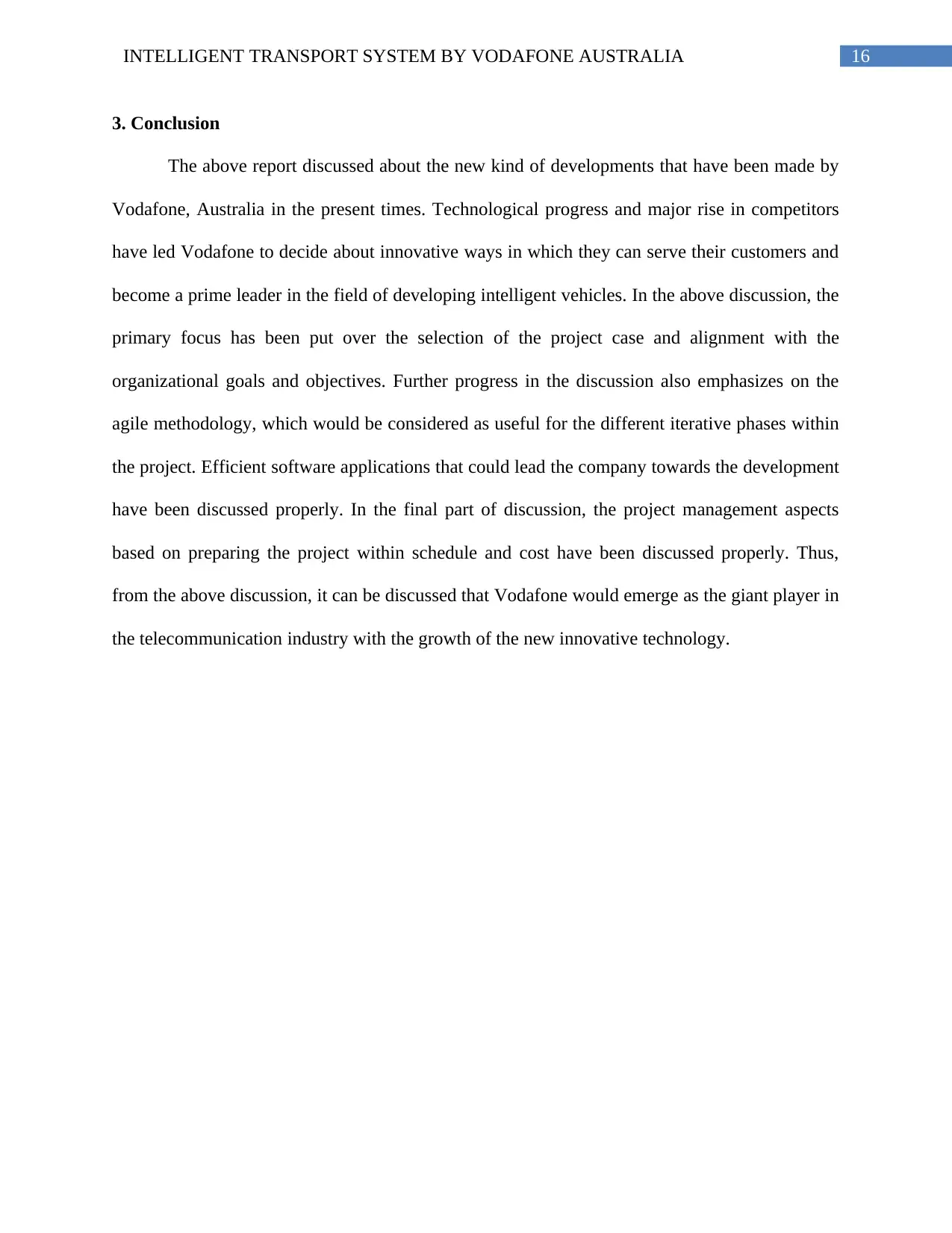
16INTELLIGENT TRANSPORT SYSTEM BY VODAFONE AUSTRALIA
3. Conclusion
The above report discussed about the new kind of developments that have been made by
Vodafone, Australia in the present times. Technological progress and major rise in competitors
have led Vodafone to decide about innovative ways in which they can serve their customers and
become a prime leader in the field of developing intelligent vehicles. In the above discussion, the
primary focus has been put over the selection of the project case and alignment with the
organizational goals and objectives. Further progress in the discussion also emphasizes on the
agile methodology, which would be considered as useful for the different iterative phases within
the project. Efficient software applications that could lead the company towards the development
have been discussed properly. In the final part of discussion, the project management aspects
based on preparing the project within schedule and cost have been discussed properly. Thus,
from the above discussion, it can be discussed that Vodafone would emerge as the giant player in
the telecommunication industry with the growth of the new innovative technology.
3. Conclusion
The above report discussed about the new kind of developments that have been made by
Vodafone, Australia in the present times. Technological progress and major rise in competitors
have led Vodafone to decide about innovative ways in which they can serve their customers and
become a prime leader in the field of developing intelligent vehicles. In the above discussion, the
primary focus has been put over the selection of the project case and alignment with the
organizational goals and objectives. Further progress in the discussion also emphasizes on the
agile methodology, which would be considered as useful for the different iterative phases within
the project. Efficient software applications that could lead the company towards the development
have been discussed properly. In the final part of discussion, the project management aspects
based on preparing the project within schedule and cost have been discussed properly. Thus,
from the above discussion, it can be discussed that Vodafone would emerge as the giant player in
the telecommunication industry with the growth of the new innovative technology.
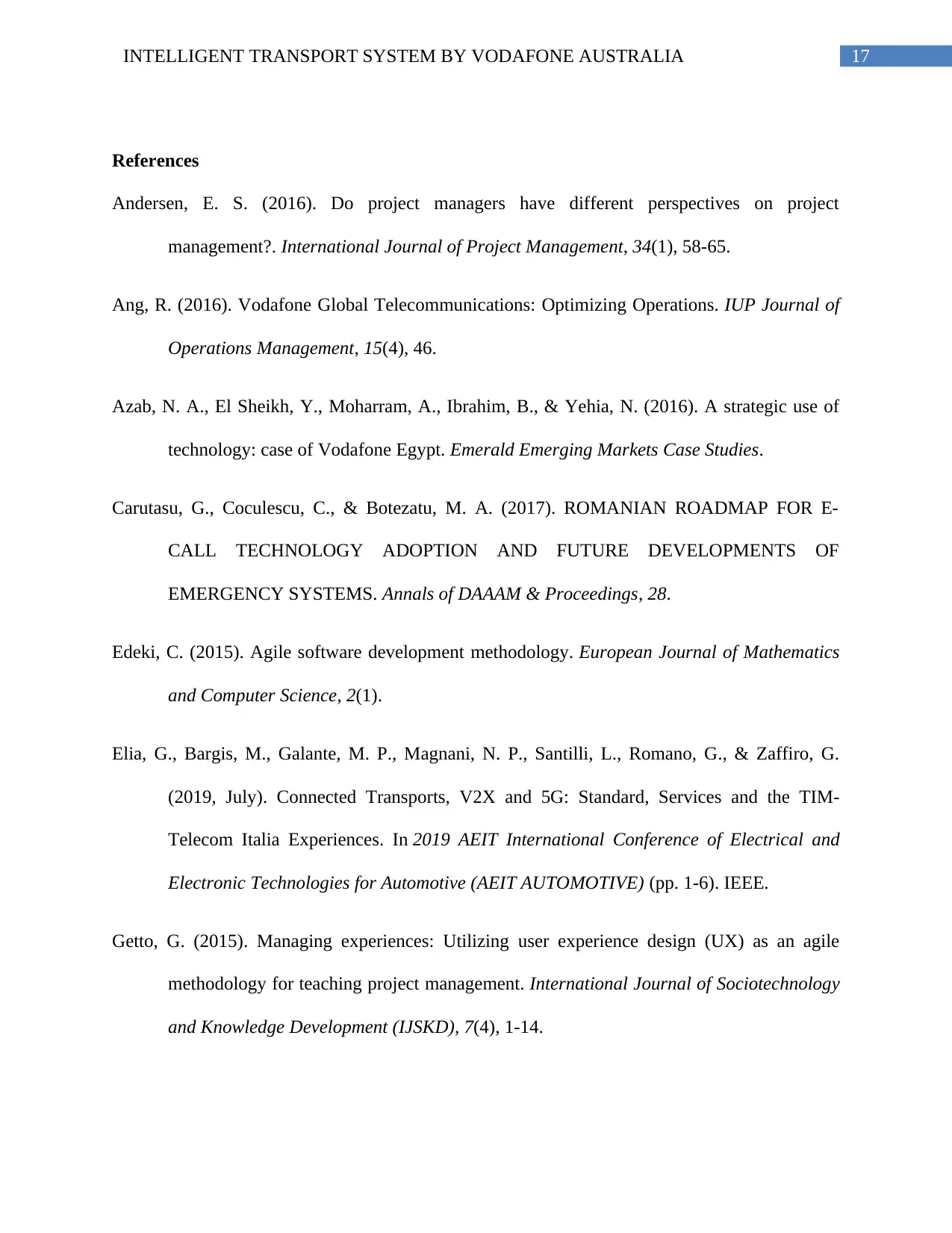
17INTELLIGENT TRANSPORT SYSTEM BY VODAFONE AUSTRALIA
References
Andersen, E. S. (2016). Do project managers have different perspectives on project
management?. International Journal of Project Management, 34(1), 58-65.
Ang, R. (2016). Vodafone Global Telecommunications: Optimizing Operations. IUP Journal of
Operations Management, 15(4), 46.
Azab, N. A., El Sheikh, Y., Moharram, A., Ibrahim, B., & Yehia, N. (2016). A strategic use of
technology: case of Vodafone Egypt. Emerald Emerging Markets Case Studies.
Carutasu, G., Coculescu, C., & Botezatu, M. A. (2017). ROMANIAN ROADMAP FOR E-
CALL TECHNOLOGY ADOPTION AND FUTURE DEVELOPMENTS OF
EMERGENCY SYSTEMS. Annals of DAAAM & Proceedings, 28.
Edeki, C. (2015). Agile software development methodology. European Journal of Mathematics
and Computer Science, 2(1).
Elia, G., Bargis, M., Galante, M. P., Magnani, N. P., Santilli, L., Romano, G., & Zaffiro, G.
(2019, July). Connected Transports, V2X and 5G: Standard, Services and the TIM-
Telecom Italia Experiences. In 2019 AEIT International Conference of Electrical and
Electronic Technologies for Automotive (AEIT AUTOMOTIVE) (pp. 1-6). IEEE.
Getto, G. (2015). Managing experiences: Utilizing user experience design (UX) as an agile
methodology for teaching project management. International Journal of Sociotechnology
and Knowledge Development (IJSKD), 7(4), 1-14.
References
Andersen, E. S. (2016). Do project managers have different perspectives on project
management?. International Journal of Project Management, 34(1), 58-65.
Ang, R. (2016). Vodafone Global Telecommunications: Optimizing Operations. IUP Journal of
Operations Management, 15(4), 46.
Azab, N. A., El Sheikh, Y., Moharram, A., Ibrahim, B., & Yehia, N. (2016). A strategic use of
technology: case of Vodafone Egypt. Emerald Emerging Markets Case Studies.
Carutasu, G., Coculescu, C., & Botezatu, M. A. (2017). ROMANIAN ROADMAP FOR E-
CALL TECHNOLOGY ADOPTION AND FUTURE DEVELOPMENTS OF
EMERGENCY SYSTEMS. Annals of DAAAM & Proceedings, 28.
Edeki, C. (2015). Agile software development methodology. European Journal of Mathematics
and Computer Science, 2(1).
Elia, G., Bargis, M., Galante, M. P., Magnani, N. P., Santilli, L., Romano, G., & Zaffiro, G.
(2019, July). Connected Transports, V2X and 5G: Standard, Services and the TIM-
Telecom Italia Experiences. In 2019 AEIT International Conference of Electrical and
Electronic Technologies for Automotive (AEIT AUTOMOTIVE) (pp. 1-6). IEEE.
Getto, G. (2015). Managing experiences: Utilizing user experience design (UX) as an agile
methodology for teaching project management. International Journal of Sociotechnology
and Knowledge Development (IJSKD), 7(4), 1-14.

18INTELLIGENT TRANSPORT SYSTEM BY VODAFONE AUSTRALIA
Ghobadi, S., & Mathiassen, L. (2016). Perceived barriers to effective knowledge sharing in agile
software teams. Information systems journal, 26(2), 95-125.
González, A., Franchi, N., & Fettweis, G. (2019, April). A Feasibility Study of LTE-V2X Semi-
Persistent Scheduling for String Stable CACC. In 2019 IEEE Wireless Communications
and Networking Conference (WCNC) (pp. 1-7). IEEE.
Gorshkov, A. S., Vatin, N. I., Rymkevich, P. P., & Kydrevich, O. O. (2018). Payback period of
investments in energy saving. Magazine of Civil Engineering, (2).
Hu, X., Cui, N., Demeulemeester, E., & Bie, L. (2016). Incorporation of activity sensitivity
measures into buffer management to manage project schedule risk. European Journal of
Operational Research, 249(2), 717-727.
Husain, S., Kunz, A., Prasad, A., Pateromichelakis, E., Samdanis, K., & Song, J. (2018,
October). The Road to 5G V2X: Ultra-High Reliable Communications. In 2018 IEEE
Conference on Standards for Communications and Networking (CSCN) (pp. 1-6). IEEE.
Intelligent Transport System. (2020). Retrieved 22 March 2020, from
https://www.vodafone.com/what-we-do/technology/innovation/innovation-stories/
intelligent-transport-system
Kerr, W. R., & Moloney, E. (2019). Vodafone: Managing Advanced Technologies and Artificial
Intelligence.
Newcomer, K. E., Hatry, H. P., & Wholey, J. S. (2015). Cost-effectiveness and cost-benefit
analysis. Handbook of practical program evaluation, 636.
Ghobadi, S., & Mathiassen, L. (2016). Perceived barriers to effective knowledge sharing in agile
software teams. Information systems journal, 26(2), 95-125.
González, A., Franchi, N., & Fettweis, G. (2019, April). A Feasibility Study of LTE-V2X Semi-
Persistent Scheduling for String Stable CACC. In 2019 IEEE Wireless Communications
and Networking Conference (WCNC) (pp. 1-7). IEEE.
Gorshkov, A. S., Vatin, N. I., Rymkevich, P. P., & Kydrevich, O. O. (2018). Payback period of
investments in energy saving. Magazine of Civil Engineering, (2).
Hu, X., Cui, N., Demeulemeester, E., & Bie, L. (2016). Incorporation of activity sensitivity
measures into buffer management to manage project schedule risk. European Journal of
Operational Research, 249(2), 717-727.
Husain, S., Kunz, A., Prasad, A., Pateromichelakis, E., Samdanis, K., & Song, J. (2018,
October). The Road to 5G V2X: Ultra-High Reliable Communications. In 2018 IEEE
Conference on Standards for Communications and Networking (CSCN) (pp. 1-6). IEEE.
Intelligent Transport System. (2020). Retrieved 22 March 2020, from
https://www.vodafone.com/what-we-do/technology/innovation/innovation-stories/
intelligent-transport-system
Kerr, W. R., & Moloney, E. (2019). Vodafone: Managing Advanced Technologies and Artificial
Intelligence.
Newcomer, K. E., Hatry, H. P., & Wholey, J. S. (2015). Cost-effectiveness and cost-benefit
analysis. Handbook of practical program evaluation, 636.
Secure Best Marks with AI Grader
Need help grading? Try our AI Grader for instant feedback on your assignments.
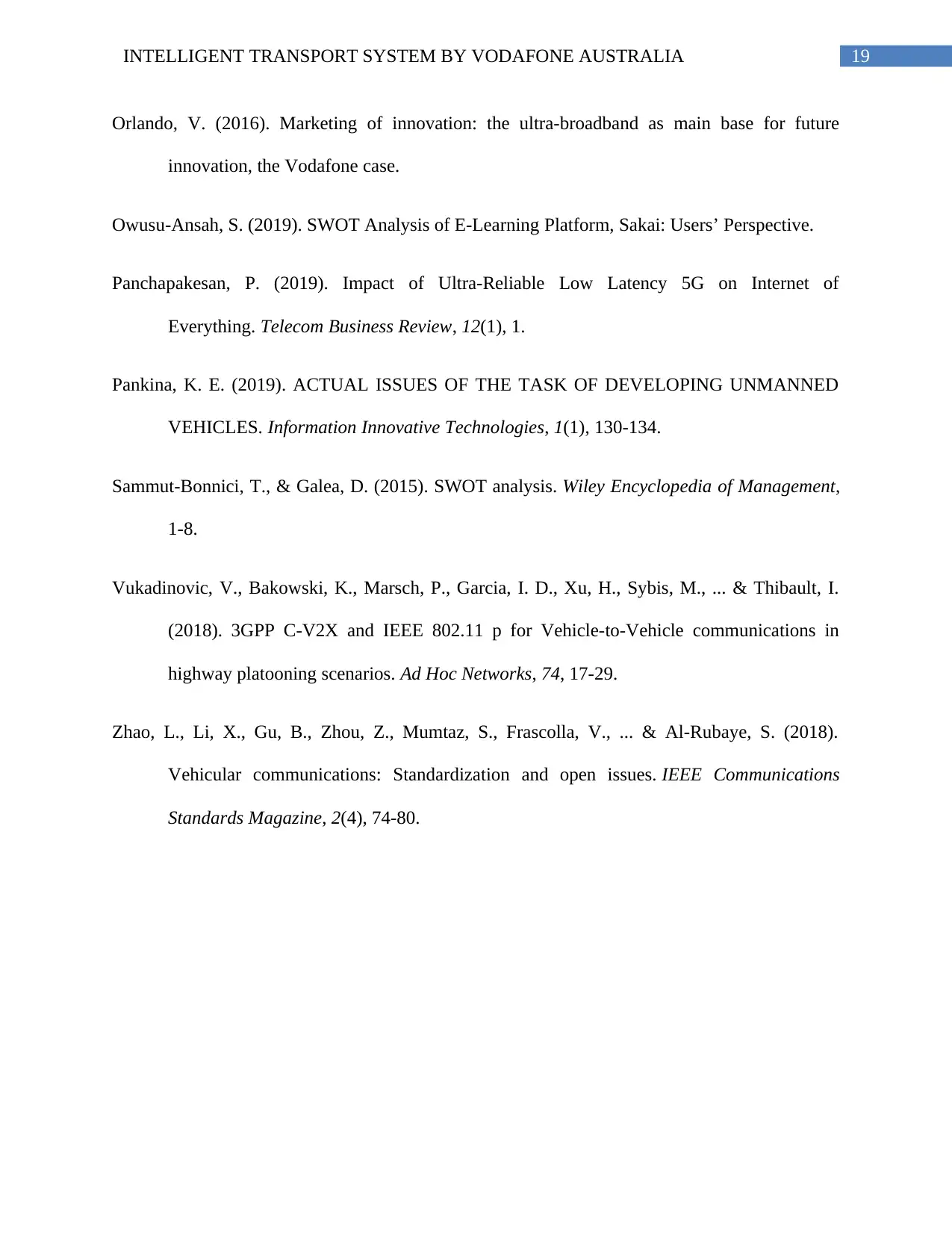
19INTELLIGENT TRANSPORT SYSTEM BY VODAFONE AUSTRALIA
Orlando, V. (2016). Marketing of innovation: the ultra-broadband as main base for future
innovation, the Vodafone case.
Owusu-Ansah, S. (2019). SWOT Analysis of E-Learning Platform, Sakai: Users’ Perspective.
Panchapakesan, P. (2019). Impact of Ultra-Reliable Low Latency 5G on Internet of
Everything. Telecom Business Review, 12(1), 1.
Pankina, K. E. (2019). ACTUAL ISSUES OF THE TASK OF DEVELOPING UNMANNED
VEHICLES. Information Innovative Technologies, 1(1), 130-134.
Sammut‐Bonnici, T., & Galea, D. (2015). SWOT analysis. Wiley Encyclopedia of Management,
1-8.
Vukadinovic, V., Bakowski, K., Marsch, P., Garcia, I. D., Xu, H., Sybis, M., ... & Thibault, I.
(2018). 3GPP C-V2X and IEEE 802.11 p for Vehicle-to-Vehicle communications in
highway platooning scenarios. Ad Hoc Networks, 74, 17-29.
Zhao, L., Li, X., Gu, B., Zhou, Z., Mumtaz, S., Frascolla, V., ... & Al-Rubaye, S. (2018).
Vehicular communications: Standardization and open issues. IEEE Communications
Standards Magazine, 2(4), 74-80.
Orlando, V. (2016). Marketing of innovation: the ultra-broadband as main base for future
innovation, the Vodafone case.
Owusu-Ansah, S. (2019). SWOT Analysis of E-Learning Platform, Sakai: Users’ Perspective.
Panchapakesan, P. (2019). Impact of Ultra-Reliable Low Latency 5G on Internet of
Everything. Telecom Business Review, 12(1), 1.
Pankina, K. E. (2019). ACTUAL ISSUES OF THE TASK OF DEVELOPING UNMANNED
VEHICLES. Information Innovative Technologies, 1(1), 130-134.
Sammut‐Bonnici, T., & Galea, D. (2015). SWOT analysis. Wiley Encyclopedia of Management,
1-8.
Vukadinovic, V., Bakowski, K., Marsch, P., Garcia, I. D., Xu, H., Sybis, M., ... & Thibault, I.
(2018). 3GPP C-V2X and IEEE 802.11 p for Vehicle-to-Vehicle communications in
highway platooning scenarios. Ad Hoc Networks, 74, 17-29.
Zhao, L., Li, X., Gu, B., Zhou, Z., Mumtaz, S., Frascolla, V., ... & Al-Rubaye, S. (2018).
Vehicular communications: Standardization and open issues. IEEE Communications
Standards Magazine, 2(4), 74-80.
1 out of 20
Related Documents
Your All-in-One AI-Powered Toolkit for Academic Success.
+13062052269
info@desklib.com
Available 24*7 on WhatsApp / Email
![[object Object]](/_next/static/media/star-bottom.7253800d.svg)
Unlock your academic potential
© 2024 | Zucol Services PVT LTD | All rights reserved.





